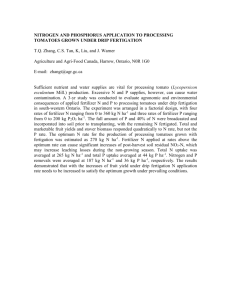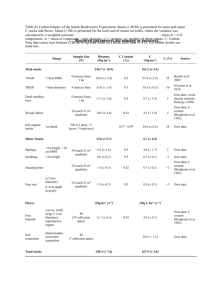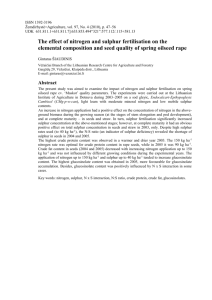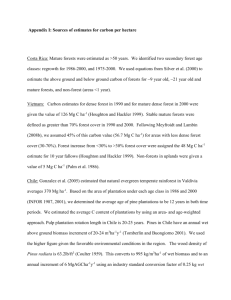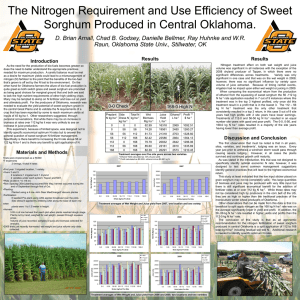Effect of Plant Density and Nitrogen Rate on Essential Oil of
advertisement
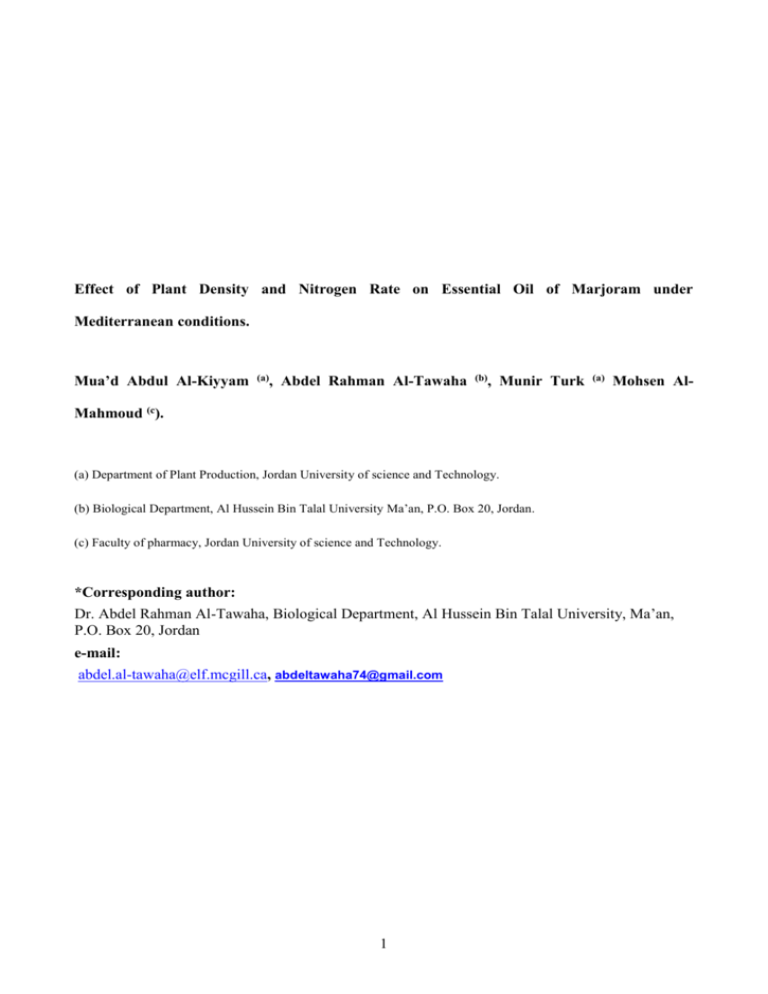
Effect of Plant Density and Nitrogen Rate on Essential Oil of Marjoram under Mediterranean conditions. Mua’d Abdul Al-Kiyyam (a), Abdel Rahman Al-Tawaha (b), Munir Turk (a) Mohsen Al- Mahmoud (c). (a) Department of Plant Production, Jordan University of science and Technology. (b) Biological Department, Al Hussein Bin Talal University Ma’an, P.O. Box 20, Jordan. (c) Faculty of pharmacy, Jordan University of science and Technology. *Corresponding author: Dr. Abdel Rahman Al-Tawaha, Biological Department, Al Hussein Bin Talal University, Ma’an, P.O. Box 20, Jordan e-mail: abdel.al-tawaha@elf.mcgill.ca, abdeltawaha74@gmail.com 1 Effect of Plant Density and Nitrogen Rate on Essential Oil of Marjoram under Mediterranean conditions. Abstract Marjoram essential oil has been reported to have beneficial effects on human health. Field experiments were conducted during the two growing seasons of 2000/01 and 2001/02 in Jordan University of Science and Technology (JUST) campus to determine the effects of plant densities (4, 6, 8 and 14 plants m-2) and nitrogen rates (0, 50, 100 and 150 kg N ha-1) on essential oil of marjoram. The quantitative determination of different oil samples was done by using GC (Varian 3300 Gas Chromatograph) equipped by flame ionization detector (FID) and coupled to an integrator (Unicam). Our results indicated that thymol yield and essential oil percentage increased significantly with reducing planting density. Highly significant differences (P≤0.01) in essential oil percentage were recorded between the nitrogen rate treatments. Increasing applied N from 50 to 100 kg ha-1 increased oil percent in all harvests then tended to decrease with increasing N up to 150 kg ha-1. On the other hand, the highest thymol percentage (53.11 %) was obtained from the highest nitrogen rate (150 kg N ha-1). It thus seems that certain agronomic practices may need to be tailored specifically for essential oil production if essential oil yield in marjoram are to be maximized. Key word: essential oil, marjoram, N rate- plant density. Introduction Marjoram is a key species used by the nutraceutical industry; it has been used medicinally at different periods in history. It contains essential oil which has important beneficial effects on 2 human health. Essential oils are mixtures of low molecular weight isoprenoid compounds, mainly C10 and C15, oxygenated. Isoprenoid compounds are widespread in nature but in aromatic plants they are secreted and stored in specialized tissues. Lawrence and Reynolds (1994) reported that chemical compositions and the concentrations of individual essential oil are variable. The authors further found that the concentrations of two predominant compounds of thyme essential oils, i.e. thymol and carvacrol have been reported to range from as low as 3% to as high as 60% of total essential oils (Lawrence and Reynolds, 1994). Essential oil is reported to have fungicidal properties in pharmaceutical, cosmetic and perfumery industries (Lawrence and Reynolds, 1994; Manou et al. 1998). Conner and Beuchat (1984) reported a strong inhibitory effect of Origanum vulgare L and Thymus vulgaris L. oils on 13 food spoilage yeast strains. The fungicidal properties of essential oils were examined on aflatoxins produced from Aspergillus species (Aspergillus flavus and A. parasiticus). Many studies have demonstrated the importance of phenolic compounds in plant defense response (Harborne, 1991; Appel, 1993). The synthesis of phenolic compounds is increased in plant tissues following infection by pathogenic organisms or feeding by herbivores (Parr and Rhodes, 1996). There are many indications that the biosynthesis and metabolism of terpenses in aromatic plants are influenced by environmental factors. Early studies have shown that environmental and management factors such as temperature, water stress, soil fertility, light, pest pressure, cutting date and plant maturity are important factors affecting concentrations of phenolic compounds in plants (Grahle and Holtzel, 1993; Piccaglia et al., 1993; Letchamo et al ., 1996; Li et al., 1996, Takano, 1996; Takano and Yamamoto, 1996; Randhawa and Kaur, 1996; Zheljazkov et al. 1996; Hassan et al., 1997; Ihsan et al., 1999; Omer, 1999; Mairapetyan et al., 1999). If environmental factor effects on marjoram essential oils have been well documented and researched, information on the effects of specific agronomic practices remains limited. The objective of this study was to determine the main effects and interactions of several agronomic factors on essential oil of marjoram. Factors studied include plant density and nitrogen level. 3 Materials and Methods Site Description Field trial was carried out at the field site of Jordan University of Science and Technology (JUST) campus in Northern Jordan [32º 34' N latitude, 36? 01' E longitude, and 520 m altitude] during the two growing seasons of 2000/01, and 2001/02. The location has Mediterranean climate of mild rainy winter and dry hot summer. The soil is fine-loamy, thermic, calcic paleargid . Important characteristics of the soil (0-15 cm depth) are summarized in Table 1. Land Preparation and Crop culture Experimental area was subject to two perpendicular chisel plow passes during the fall season. Field was disked before transplanting time to provide a proper seedbed. Experimental plots of 2.25 X 1.8 m were established. The experiments were arranged in a Randomized Complete Block Design (RCBD) and replicated three times. Plowing operations were done, by chisel to a depth of 20 to 25 cm followed by rotary harrow to level soil surface. Four-month-old Marjoram seedlings with an average height of 20 cm were obtained from Nour AI Hussien Foundation (NAHF). Hardening of seedlings before transplanting was accomplished by exposing them to low temperature, and to adapt them to the JUST field condition during winter season. Transplanting was carried out to the experimental plots on 15 May, 2001; each plot was consisted of four rows, the outer ones considered as a border lines. Seedling plants were grown under irrigation using drip irrigation system. However, irrigation intervals and amount of water added were adjusted to maintain optimum moisture availability, and the total amount of water was 800 m3/ha during the whole growing season. Three cuttings were done during the first growing season; the first, the second and the third harvest were on 6th July, 18th August and 14th October 2001, respectively. Whereas, the other three cuttings were done during the second season; the first, the second, and the third harvest 4 were on 25th May, 18th July and 10th September, 2002, respectively. Cutting height was around 7cm above soil surface. Treatments The treatments were factorial combinations of four plant densities (4, 6, 8 and 14 plants m-2) and four rates of nitrogen fertilizer (0, 50, 100 and 150 kg N ha-1). The plant densities were 4, 6, 8 and 14 plants m-2 were obtained by have 60, 45, 30 and 15 cm between plants of the same row , respectively, while distance between rows was kept constant at 75 cm for all treatments. Nitrogen fertilizer was added in the form of Urea (NH2) Co (46% N) at transplanting time and a day after each harvest, all of which resulted in a total seasonal rate of (0, 50, 100 and 150 kg ha-1). Nitrogen fertilizer treatments varied according to rate of application and were devised to provide for control with no fertilizer and various rates of split application. Essential Oil Distillation, Gas Chromatographic Analysis Separation of Oils Origanum syriacum L. plants were collected from the field after each harvest. The plants were dried in oven at room temperature for few days. Dehydrated plants were weighed and powdered by blender then macerated for 24-h in 90 ml distilled water at room temperature. Steam distillation was performed for 4-h by modified steam distillation apparatus. The essential oil was extracted from the distillate by chloroform (CHCl3). Chloroform layer was separated and then dried with Na2SO4. Chloroform was evaporated under reduced pressure (in vacuo) at 35˚ C by using rotary evaporator. The essential oil content was determined gravimetrically on shoot dry matter basis. Oil extracted from plant leaves was determined on fresh weight basis. Qualitative and Quantitative analysis of Oils: 5 Thin layer chromatography (TLC) was performed as cited in (Wagner et al., 1984) for the qualitative identification of Thyme oil on silica gel plates (stationary phase). The mobile phase used in (TLC) was 93% tolouene + 7% ethyl acetate. Reagents were ethanolic (conc.) sulfuric acid 95:5 (solution I) and ethanolic vanilin 99:1 (solution II). Detection was performed by spraying vigorously the silica gel plate with solution I (10 ml) and immediately with solution II (5-10 ml). Silica gel plates were oven dried at 110º C for one minute. The quantitative determination of different oil samples was done by using GC (Varian 3300 Gas Chromatograph) equipped by flame ionization detector (FID) and coupled to an integrator (Unicam). For separation of thymol, column of Stainless steel (2m X 1/8") was packed with 15% Carbo Wax 20M, with W 80-100 mesh. The carrier gas was N2 with flow rate of 16-ml sec-1. The injector and detector temperatures were held at 240° C and 250° C, respectively. The essential oil samples were diluted with n-hexane (HPLC grade), and 4µL were injected from samples of plant tissues oil, and 2µL were injected from samples of plants. Oil samples of each treatment were analyzed separately. The area BC for Thymol was averaged and Thymol percentage was determined according to the calibration curve (Figure 1). Statistical Analysis The data was analyzed as RCBD with two factors (plant density and nitrogen fertilizer rate). The means were separated by using Fisher least significant differences (LSD) according to Steel and Torri (1980) by using MSTAT-C software (Michigan State University, 1988). Results and Discussion The percentage of volatile oil in the air dried herb increased gradually with increasing plant age. Thereafter, a decline occurred toward the end of the growing season. Differences in oil 6 content among the harvest dates can probably be attributed to differences in various factors including photosynthesis, temperature and light levels. Light levels and temperature (Table 2) were especially high during growth period of the plants which contained the highest oil percentage (the 2nd harvest, 1.84% compared with first harvest (1.64%) and third harvest (1.67%).The biosynthesis of secondary metabolites has been related to the capture of light energy. In general, light stimulates the synthesis of phenololic compounds. Various researchers have reported an increased production of phenololic compounds with UV radiation stress (Caldwell et al., 2005; Schmelzer et al., 1988; Tevini et al., 1991; Kubasek et al., 1992). It has been reported that plant flavonoid biosynthesis genes are transcriptionally activated by light, where phenololic compounds may provide defence against ultraviolet light (Stapleton, 1992). Hughes et al. (1999) found that exposure of root systems of alder plants to light can promote the synthesis of flavonoids. They also observed increased levels of phenololic compounds in plants supplemented with UV light. There was no interaction between plant density and nitrogen rate: results are thus presented for main effects only. Highly significant differences (P≤0.01) in essential oil percentage were recorded between the plant density treatments (Table 3). Our data as well as reports in the literature suggest that the essential oil percentage was significantly increased as planting density decreased (Ihsan et al., 1999). The increased number of essential oil glands present in the leaves of the plants grown under supplemental light, compared with those grown under natural light agrees with the findings of Yamaura et al. (1989) through his work with Thymus vulgaris, who indicated that thyme seedlings developed under light produced more glandular trichomes than those seedlings developed in darkness. The essential oil glands are secretions from capitate or peltate glandular trichomes, and may contain both lipophilic and polysaccharide substances in other examined species of the Labiatae. The positive correlation between the number of essential oil glands and oil content may suggest that the concomitant increase in light may increase the formation of essential oil glands 7 with subsequent increase in essential oil content. On the other hand, the lower content of essential oil of closely planted crop could be due to the fact of mutual shading; there was more shedding of the older and lower leaves which are rich in volatile oil contents, thereby decreasing their proportion in the herb and ultimately causing the reduction in the content of essential oil (Randhawa and Kaur, 1996). This is somewhat consistent with observations of Li et al. (1996), who reported that herb yield and essential oil production were directly connected with biomass production and thus to photosynthesis because both herb yield and essential oil production increased with increasing in light level. Peltate hairs are important site for synthesis and accumulating essential oil in herbs, especially for accumulating monoterpenes, sesquiterpenes and diterpenes. The density of peltate hairs of marjoram significantly increased as light level increased with the highest derivative occurring at 100 % of full sunlight, suggesting the effect of light on peltate hair. In the first cutting, plant density (4 plants m-2) gave significantly higher essential oil compared with other densities 6, 8 and 14 plants m-2, and the differences were 5.02 %, 13.41 % and 14.52 %, respectively. Where 8 plant m-2 plant densitiy show no significant differences from the 14 plant m-2 plant density. Similar trend was obtained at the second cutting, at which (4 plants m-2) gave significantly higher essential oil (1.95 %) than other treatments. This increase was 3.59 % over 6 plants m-2, 7.69 % over 8 plants m-2 and 10.77 % over 14 plants m-2 plant densities. The lowest plant density (4 plants m-2) gave the highest mean essential oil yield (1.81 %) and this was higher than 6, 8 and 14 plants m-2 plant density by 5.52 %, 9.39 % and 15.47 %, respectively at third cutting. Highly significant differences (P≤0.05) in essential oil percentage were recorded between the nitrogen rate treatments (Table 3). Application of N increased oil percent at rates 15.6, 14.6 and 10.2% in the first, second and third harvest of the second season, respectively (Table 3). Increasing applied N from 50 to 100 kg ha-1 increased oil percent in all harvests then tended to decrease with increasing N up to 150 kg ha-1, but still over estimated the level of oil percent in control plants. It means that essential oil percent gradually decline with increasing N rate over 100 8 kg ha-1. The response of volatile oil content to N application might be attributed to increase in capacity of de nuvo meristimic cells metabolism in building dry matter and/or its compensation with active ingredient production with the results that the plant demands increasing in nutrient elements, such as N (Omer, 1999). In this respect, Geunther (1973) claimed that the precursor of essential oil could be obtained through degradation of carbohydrate and proteins. Pridham (1976) also mentioned that certain compounds, like sugar and amino acid, are capable of being translocated into the site of essential oil synthesis and ultimately used during synthesis of monoterpenes. In this view; it seems that increasing N application leads to realizing a case of steady state or absence of competition on carbon skeletons necessary to meristimic and volatile oil production through acetate while N thresholds had stabilized the maintenance of N necessary for growth and activity, e.g., protenaseous enzymes. Oil concentration deceased with increasing nitrogen application up to 150 kg ha-1, being greater with no applied N. this was probably because plants growing with N fertilization were less mature and at earlier stage of development than those with no N. Results of the first harvest at the second season showed that at the nitrogen rate 100 kg N ha-1, the highest essential oil yield was obtained (1.79 %), which was higher than 150, 50 and 0.0 kg N ha-1, by 8.94 %, 8.38 % and 15.64 %, respectively. The rate (100 kg N ha-1) gave higher yield of essential oil than 150 kg N ha-1 by 7.03 %, than 50 kg N ha-1 by 8.04 % and than 0.0 kg N ha-1 by 14.57 % at the second harvest in the second growing season. Similar trend was obtained at the third cutting (second growing season); at which 100 kg N ha-1 gave significant yield (1.77 %) than other treatments. This increase was 7.91 % over 150 kg N ha-1, 5.08 % over 50 kg N ha-1 and 10.17 % over 0.0 kg N ha-1. Thymol and its isomer carvacrol are the main constituents of essential oil of marjoram plants which followed by their hydrocarbon precursors (p-cymene and γ-terpinene). There was a good correlation between the fresh thymol yield of marjoram and the three harvest dates. 9 Qualitative analysis by TLC (Figure 1) showed the presence of thymol in the plant tissues of the study. Thymol percentage at the second harvest (57.18 %) was much higher than that of the first harvest (50.14 %) by 12.31 %, and was higher than that of the third harvest (39.74 %) by 30.94 %. The increase in thymol percentage after the first harvest and the decrease after the second harvest was probably due to thymol percentage increases in warm season because of high temperature and decrease in low temperature. Similar results were reported by Omer (1999). Who found that the thymol and carvacrol as the two main constituents' of oregano oil in the three successive cuttings from mid-summer to early winter, followed by their hydrocarbon precursors (p-cymene and γterpinene). The main differences were recorded with these four compounds in which phenolic terpene compounds, thymol, and carvacrol, increased in warm season at the expense of their preceding precursors. And higher temperatures were found favorable to accumulate higher thymol contents. Thymol percentage has been significantly (P≤0.05) affected by planting density (Table 4). The general trend indicated that thymol yield increased significantly with reducing planting density. The lowest density (4 plants m-2) gave the highest yield for all harvests (53.39 %). Similar results have been obtained with Mentha arvensis L.(Randhawa and Kaur, 1996), and sage (Salvia officinalis) and thyme (Thymus vulgaris) (Li et al.1996). The increases in thymol percentage of Origanum syriacum as plant density decreases were probably due to the solar radiation available around the plants. Similar results reported by Letchamo and Gosselin, who indicated that the thymol is biosynthesized from the hydrocarbon precursors (p-cymene and γ-terpinene) which increased as plant density decreased. These precursors were higher in plants under supplemental light than those under normal light because the biosynthesis or enzymes responsible for conversion, of these two thymol precursors was strongly photoregulated and the activity of the enzymes catalyzing the reaction of accumulation monoterpenes could also be affected by light (Li et al.1996). In the first cutting at, plant density (4 plants m-2) gave significantly higher yield compared with densities 6, 8 and 14 plants m-2, and the differences were 5.19 %, 11.85 % and 20.51 %, 10 respectively. Similar trend was obtained at the second, at which 4 plant m-2 gave significantly higher yield (60.91 %) than other densities. This increase was 3.05 % over 6 plant m-2, 8.13 % over 8 plants m-2 and 12.83 % over 14 plants m-2. The lowest densities (4 plants m-2) gave the highest mean yield and were 43.91 % and this higher than 6, 8 and by 7.01 %, 12.43 % and 18.58 %, respectively at third cutting. The analysis of variance showed that there were highly significant (P≤0.01) effects of nitrogen fertilizer rate on thymol yield of marjoram plants at all harvests (Table 4). The highest thymol percentage recorded (53.11 %) was obtained from the highest nitrogen rate (150 kg N ha-1), as the nitrogen rate increased the thymol yield was increased (Table 4). However in the first harvest, 150 kg N ha-1 produced the highest yield, it was 55.14 % and significantly higher than 100 kg N ha-1, 50 kg N ha-1 by 12.55 % and 0 kg N ha-1 by 16.49 %. Concerning the second harvest, the highest nitrogen rate (150 kg N ha-1) gave significantly the highest fresh yield than other plant densities, and was 60.72 %. The increase was 4.00 % over 100 kg N ha-1, 7.76 % over 50 kg N ha-1 and 11.08 % over 0 kg N ha-1. With regard to, harvest number three, the highest nitrogen rate (150 kg N ha-1) gave significantly the highest fresh thymol yield and was 43.47 %, and significantly higher than100 kg N ha-1 by 6.86 %, 50 kg N ha-1 by 12.95 % and 0 kg N ha-1 by 14.54 %. No significant differences were found when 100 and 150 kg N ha-1 were used. The N fertilization seems to increase the biosynthesis of thymol and carvacrol to the disadvantage of γterpinene and p-cymene. This may be explained in view of the fact that γ-terpinene and p-cymene are the biogentic precursors of thymol and carvacrol. It is generally said that plants respond to suboptimal soil fertility levels by increasing the synthesis and accumulation of phenolic compounds in their tissues. However, results of studies investigating the effects of fertilization on phenolic compounds concentration are contradictory; response may vary with species, elements and level of the stress. Seguin et al. (2003) found that K, P, S and B fertilization had limited impact on soybean seed flavonoids content in fields with medium to high soil fertility. On the other hand, Vyn et al. (2002) observed positive effects of K fertilization on flavonoids concentration of soybean seed on 11 low- to medium-testing K soils. Carpena et al. (1982) reported that tomato response may vary depending on the element. They reported that while B deficiencies result in increased flavonoid accumulation in leaves, P and Mn deficiencies do not affect the total flavonoids content but rather affect the types of flavonoids present. Stout et al. (1998) reported that, in greenhouse trials, tomato leaf grown at low N availability had greater flavonoid content. Most studies on the effects of mineral nutrition have been conducted under controlled conditions and there is still limited information on the impact of fertilization strategies on concentrations and yields of phenolic compunds in field-grown marjoram under Mediterranean conditions. Conclusions The present study suggests that environmental and agronomic factors have a great impact on essential oil of marjoram under Mediterranean conditions. The highest Thymol yield and essential oil percentage was recorded at the lower plant density and the lowest at the higher plant density. Increasing applied N from 50 to 100 kg ha-1 increased oil percent in all harvests then tended to decrease with increasing N up to 150 kg ha-1. In contrast, the highest thymol percentage (53.11 %) was obtained from the highest nitrogen rate (150 kg N ha-1). It thus seems that certain agronomic practices may need to be tailored specifically for essential oil production if concentrations in marjoram are to be maximized. References Appel, H. 1993. Phenolics in ecological interactions: The importance of oxidation. J. Chem. Ecol. 19: 1521-1552. Carpena, O., Zornoza, P., Mataix, J. 1982. Incidence of P, Mn and B deficiencies on the levels of the whole and individual flavonoid groups in tomato leaves. J. Plant Nut. 24: 1197-1208. Conner, D.E., Beuchat, L.R. 1984. Effects of essential oils from plants on growth of food spoilage yeasts. J. Food Sci. 49: 429–434. Caldwell, C. R., Britz, S. J., Mirecki, R. M. 2005. Effect of temperature, elevated carbon dioxide, and drought during seed development on the isoflavone content of dwarf soybean [Glycine max (L.) Merr.] grown in controlled environment. J. Agric. Food Chem. 53:1125-1129. 12 Harborn, J. B. 1991. Flavonoid pigments, G. A. Rosenthal and Berenbaum M. B. (eds.). Herbiverse. Their interactions with secondary plant metabolities, Vol I. Academic Press, New York, USA, 452p. Hughes, M., Donnelly, C., Crozier, A., Wheeler, C. T. 1999. Effects of the exposure of root of Alnus glutinosa to light on flavonoids and nodulation. Can. J. Bot. 77: 1311-1315. Kubasek, W. L., Shirley, B. W., McKillop, A., Goodman, H. M., Briggs, W., Ausubel, F. M. 1992. Regulation of flavonoid biosynthesis genes in germinating Arabidopsis seedlings. Plant Cell. 4: 1229-1236. Grahle, A., Hoetzel, C. 1993. Photoperiod dependence of the formation of essential oils in Mentha piperita, Naturwissenchaften, 50, pp. 552. Guenther, E. 1973. The essential oil, Van Nostrand Co., Inc., New York. Hassan, S. M., Naglaa, S. A., Omer, E. A., Eissa, A. M. 1997. Response of Origanum syriacum to foliar application of urea and cycocel, Zagazig J. Agrec. Res. 24: 785-803. Ihsan, S. A., Al-Sahhaf, F. H., Al-Askary, A. A. 1999. Effect of nitrogen fertilization, plant density and time of cutting on the dry yield and oil yield of Mentha spicata L. and Mentha longifolia var. asiatica(Boriss)Rech. F., Iraqian Journal of Agricultural Science 30(2):169-185. Lawrence, B. M., Reynolds, R. J. 1994. Progress in Essential Oils Perfu. Flav. 19: 31-44 Manou, I., Bouillard, L., Devleeschouwer, M. J, Barel, A. O. 1998. Evaluation of the preservative properties of Thymus vulgaris essential oil in topically applied formulations under a challenge test. J Appl Microbiol. 84(3):368-76. Parr, A. J., Rhodes, M. J. C. 1996. Natural plant defence mechanisms. Protection agents from nature. Edited by LG Copping Royal Society of Chemistry, Cambridge, U. K, 301-328p.W. Letchamo, A. Gosselin, T. 1996. Transpiration, essential oil glands, epicuticular wax and morphology of Thymus vulgaris are influenced by light intensity and water supply, Journal of Horticultural Science. 71:123-134. Li Y., Craker, L. E., Potter, T. 1996. Effect of light level on essential oil production of sage (Salvia officinalis) and thyme (Thymus vulgaris). Acta Horticultura. 426: 419-426. Mairapetyan, S., Tadyvosyan, A., Alexanyan, S., Stepanyan, B. 1999. Optimization of the N: P: K ratio in the nutrient medium of some soilless aromatic and medicinal plants. Acta Horticultura, 502: 29-32 Omer, E. A. 1999. Response of wild Egyptian oregano to nitrogen fertilization in sandy soil, Journal of Plant Nutrition. 22:103-114. Piccaglia, R., Dellaceca, V., Marotti, M., Giovanelli, E. 1993. Agronomic factors affecting the yields and the essential oil composition of peppermint (Mentha x Piperita L.). Acta Horticultura. 344: 29-40. 13 Pridam, J. B. 1976. Terpenoids in plant, Academic Press, London, England. Randhawa, G. S., Gill, B. S., Saini, S. S., Singh, J. 1996. Effect of plant spacing and nitrogen levels on the seed yield of dillseed (Anthium graveolense L.). Acta Horticultura 426: 623-628. Randhawa, G. S., Kaur, S. 1996. Optimization of harvesting time and row spacing for the quality oil in Japanese mint (Mentha arvensis L.) varieties, Acta Horticultura. 426:115-622. Seguin, P., Zheng, W. 2006. Potassium, phosphorus, sulfur and boron fertilization effects on soybean isoflavone content and other seed characteristics. J. Plant Nutr. 29: in press Steel, R., Torrie. J.T. 1980 Principles and proceduresin statistics: a biometrics approach. 2 edn. New York, Mc Graw-Hill Book . Schmelzer, E., Jahnen, W., Hahlbrock, K. 1988. In situ localization of light-induced chalcone synthase mRNA, chalcone synthase, and flavonoid end products in epidermal cells parsley leaves. Proc. Natl. Acad. Sci. U.S.A. 85: 2989-2993. Stapleton, A. E. 1992. Ultraviolet radiation and plants: burning questions. Plant Cell. 4: 1353-1358. Stout, M. J., Brovont, R. A., Duffey, S. S. 1998. Effect of nitrogen availability on expression of constitutive and inducible chemical defenses in tomato, Lycopersicon esculentum. J. Chem. Ecol. 24: 945-963. Takano, T., Yamamoto, A. 1996. Effect of anion variation in a nutrient solution on basil growth, essential oil content, and composition. Acta Horticultura. 426:389-396. Takano, T. 1993. Effect of soil conditioner and K-Ca ratio in soil nutrient solution on the growth of marjoram plants. Acta Horticultura. 344: 462-467. Tevini, M., Braun, J., Fieser, G. 1991. The protective function of the epidermal layer of rye seedlings against ultraviolet-B radiation. Photochem. Photobio. 53: 329-333. Vyn, T. J., Yin, X., Bruulsema, T. W., Jackson, C. C., Rajcan, I.., Brouder, S. M. 2002. Potassium fertilization effects on isoflavone concentrations in soybean (Glycine max (L.) merr.). J. Agric. Food Chem. 50: 3501-3506. Zheljazkov, V., Margina, A. 1996. Effect of increasing doses of fertilizer application on quantitative and qualitative characters of mint. Acta Horticultura, 426:579-592. 14 Table 1. Some selected pre-experimental physical and chemical properties of the study soil in the top 15-cm depth. Soil property CaCo3 Organic matter N-NH4 (mg kg-1) N-NO3 (mg kg-1) Available P (mg kg-1) pH Sand (%) Silt (%) Clay (%) Value 13.0 0.79 5.25 16.78 3.33 7.93 5.5 61.0 33.5 15 Table 2. Maximum and minimum air temperatures at JUST during the 2001/02 growing seasons. MONTHE January February March April May June July August September October November December MAXIMUM (Cº) 2001 2002 15.48 11.76 15.26 16.24 23.51 21.27 25.28 21.75 26.21 27.35 32.88 31.46 33.97 34.06 33.66 33.28 30.78 32.06 28.14 29.44 20.08 22.29 16.06 14.78 16 MINIMUM 2001 4.45 5.17 9.49 11.96 13.98 16.61 18.15 18.42 16.42 14.23 8.41 6.60 (Cº) 2002 3.61 6.19 7.59 8.99 11.45 15.58 19.29 18.28 16.28 16.11 9.53 5.74 Table 3. Effect of planting density and nitrogen fertilizer rate on Essential Oil % of marjoram at three harvests on the second season 2001/02. Planting density (plant m-2) Nitrogen Fertilizer (kg ha-1) 14 0 50 100 150 1.25 1.53 1.79 1.54 Mean 1.53 0 50 100 150 1.62 1.72 1.91 1.72 Mean 1.74 0 50 100 150 Mean Mean 8 6 First Harvest 1.43 1.64 1.52 1.69 1.62 1.82 1.64 1.63 4 1.72 1.82 1.91 1.72 1.51 1.64 1.79 1.63 1.55 1.70 Second Harvest 1.63 1.74 1.83 1.83 1.92 2.01 1.84 1.93 1.79 LSD=0.08 1.82 1.93 2.13 1.92 1.70 1.83 1.99 1.85 1.95 LSD=0.06 1.43 1.53 1.61 1.54 1.80 1.88 Third Harvest 1.52 1.64 1.61 1.73 1.71 1.85 1.65 1.62 1.75 1.85 1.92 1.72 1.59 1.68 1.77 1.63 1.53 1.64 1.81 LSD=0.04 1.71 17 Table 4. Effect of planting density and nitrogen fertilizer rate on Thymol % of marjoram at three harvests on the second season 2001/02. Nitrogen Fertilizer (kg ha-1) Planting density (plant m-2) Mean 14 8 6 4 First Harvest 0 50 100 150 39.05 40.35 46.33 50.21 44.33 47.86 49.65 53.26 48.47 51.21 52.65 57.56 52.36 53.45 56.01 59.54 46.05 48.22 51.16 55.14 Mean 43.99 55.34 LSD=1.65 0 50 100 150 49.25 51.24 54.32 57.55 48.78 52.47 Second Harvest 52.36 56.65 55.32 58.22 56.48 60.01 59.68 61.33 57.69 59.26 62.35 64.32 53.99 56.01 58.29 60.72 Mean 53.09 60.91 LSD=2.09 0 50 100 150 32.25 34.26 37.45 39.04 55.96 59.05 Third Harvest 35.35 39.36 36.54 38.54 39.56 40.32 42.34 45.13 41.65 42.01 44.65 47.35 37.15 37.84 40.49 43.47 Mean 35.75 38.45 43.91 LSD=2.35 40.83 18 1000000 y = 835.51x + 221.39 R2 = 0.9995 Area 800000 600000 400000 Series1 200000 Linear (Series1) 0 0 500 1000 1500 Thymol Concentration (ppm) Figure 1. Calibration Curve of Thymol Standard 19
